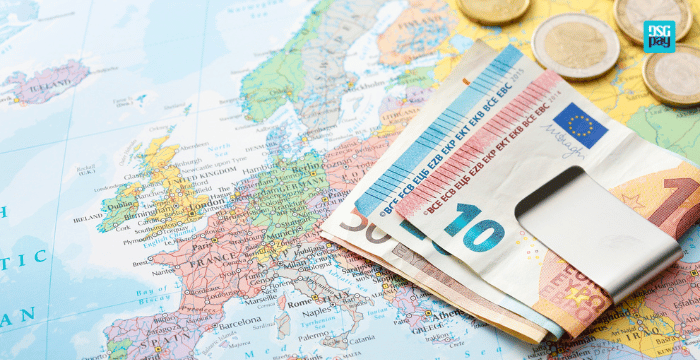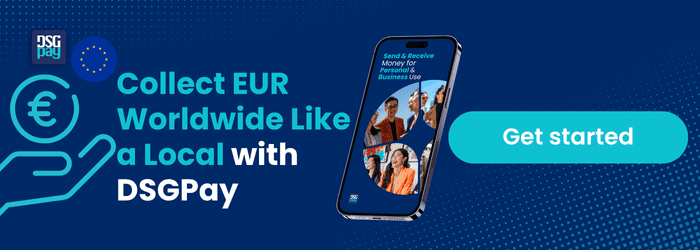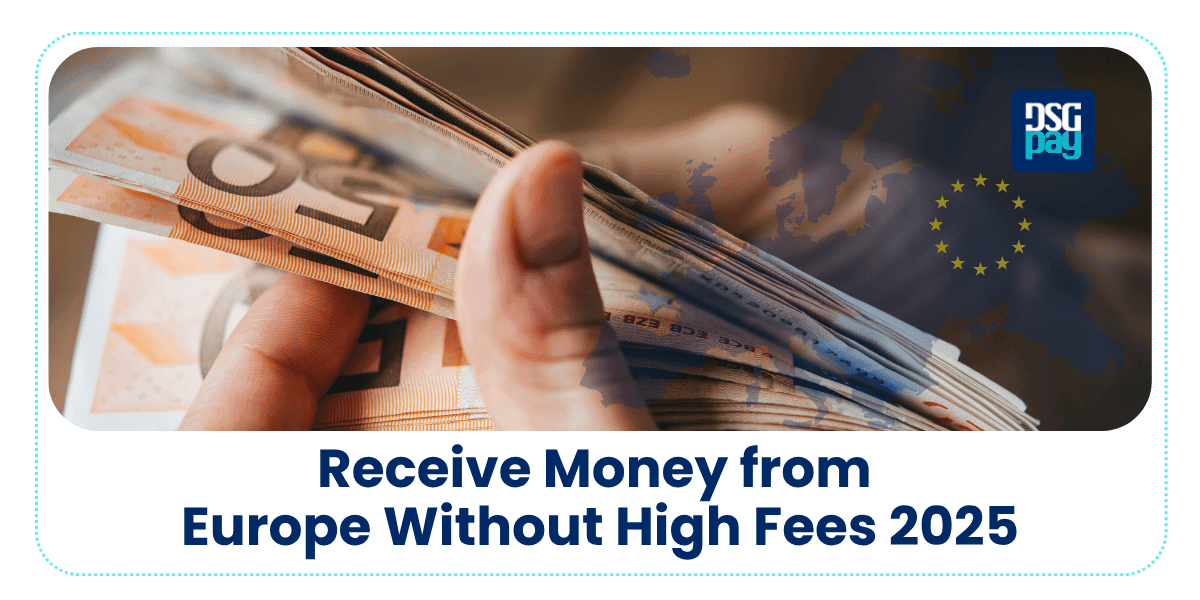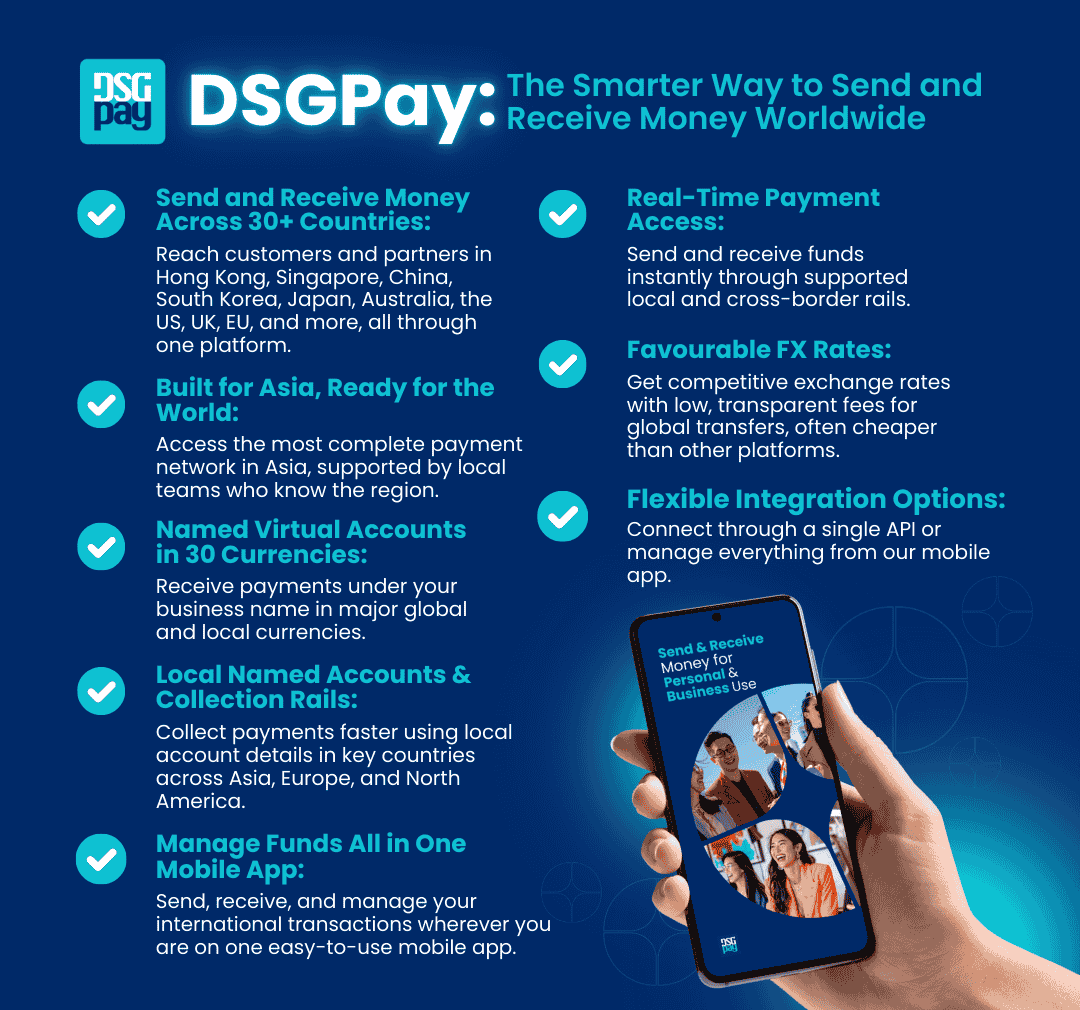If you’re living outside Europe or conduct your business overseas, you’ll quickly realise that it’s quite difficult to receive money from Europe.
With the exorbitant fees or not knowing where to start, it’s very likely you’d get stuck.
This article explains the best ways to receive money from Europe, and includes tips to help you save more of your hard-earned money.
Table of Contents
Receive Money from Europe: Challenges & Setbacks
If you’re planning to receive money from Europe, here are a few challenges you may face along the way:
- High Fees: Fees, such as intermediary bank fees, high exchange rate margins, conversion to local currency fees, etc., could accumulate into a high value. This makes it very inconvenient to receive money from Europe.
- For example, imagine paying as high as $100 on a $1000 transaction. These high costs are tracked and documented globally by financial institutions and organisations like the World Bank’s Remittance Price Worldwide initiative.
- Hidden Charges: Several providers include hidden charges in their transactions, thereby increasing the value of the fees you’re expected to pay.
- Slow Network Service: Based on a World Bank report, it takes about three business days or more to conduct international transfers, particularly if it’s going outside the Eurozone. If you’re looking for a faster channel, you might find yourself getting stuck.
- Checks and Compliance: Verifications for compliance with financial regulations or anti-money laundering checks could also affect transfer times and incoming transfer fees.
- Limited Payout Options: In some countries, to receive money from Europe, you can only withdraw through specific banks or cash pickup centres.
- Limits on Transaction Volume: Some services are limited by the amount of money their accounts can receive at a time.
These challenges and setbacks make choosing the right transfer method critical.

Best Ways to Receive Money From Europe in 2025
The best ways to receive money from Europe are through:
1. Digital Wallet Platforms
A digital wallet is a software-based system, accessible on a smart device, that can store your payment information, such as credit and debit card details. Examples of Digital wallet apps: Skrill, Zelle, Apple Pay, Google Pay, etc.
How it works
To receive money from Europe using a digital wallet, the sender links a card or bank account to their wallet app and sends the funds to your digital wallet using your registered details. This could include your email address, phone number, and a unique QR code, among other details. You can then move the funds from the wallet to your linked local bank account.
Pros
- Transfers are instant or within minutes.
- Minimal transfer fees.
- Use near mid-market exchange rates.
- Funds can often be used directly in-app or with a linked card.
Cons
- Fees are incurred when withdrawing from the wallet to local bank accounts.
- Some digital wallets (like Zelle) are regionally restricted and don’t support international transfers.
Best For: Freelancers, students, and businesses looking to streamline payments from abroad accounts.
2. Direct Bank Transfers (SEPA)
If you’re sending or receiving a large amount within the EU, transfers through the SEPA (Single Euro Payments Area) are a renowned option.
How it works
The sender uses a European bank to transfer Euros through the SEPA network to the receiver’s European IBAN. Transfers are typically available only within the SEPA zone (EU and select non-EU countries). For non-EU residents, SEPA transfers can still be received if they hold a Euro-denominated IBAN provided by a regulated payment provider.
Pros
- Often free or very low-cost within the SEPA zone.
- Highly secure and very reliable for receiving large sums.
- No currency conversion needed for Euro-to-Euro payments.
Cons
- Transfer can take anywhere from one business day (SEPA) to several days (SWIFT, for non-SEPA banks).
- Additional fees and unfavourable exchange rates often apply when intermediary banks are involved.
Best For: People receiving large transfers for investments, tuition, or business payments, where security and stability matter more than speed.
3. Online Money Transfer Platforms
Online money transfer platforms are widely used for personal remittances and cross-border support. This flexibility makes them attractive in regions where not everyone has easy access to a bank account or a digital wallet. Popular examples include Wise, Remitly, Xoom, and Western Union.
How it works
The sender initiates a transfer online or via an app and chooses a payout method: bank deposit, mobile wallet, or cash pickup. Funds are typically converted immediately at the time of sending.
Pros
- Easy to use with a wide global network.
- Multiple payout options: bank, wallet, or cash pick up.
- Rapid settlement times.
- Good in regions with limited banking infrastructure.
Cons
- Hidden exchange rate markups.
- Rates and fees vary depending on the country and payment method.
Best For: Families and individuals who need flexibility (cash pickup, mobile wallet) and want access to a wide global network, even in countries with limited banking infrastructure.
4. Cryptocurrency Transfers
Crypto transfers are an increasingly popular way for individuals and businesses to receive money from Europe without relying on traditional payment rails. Through exchanges like Binance or Coinbase, users can receive money from Europe using stablecoins like USDT.
How it works
The sender converts Euros to a cryptocurrency (often a stablecoin like USDT) and sends it directly to your crypto wallet address. You then sell the crypto for your local currency on an exchange or P2P marketplace.
Pros
- Low transaction fees, typically minimal ($2-$15).
- Transactions can be completed in minutes.
- Global accessibility, as anyone with a crypto wallet can receive funds.
Cons
- Price volatility.
- Requires knowledge of crypto wallets and exchanges.
- Security risks if users lose private keys or fall victim to scams or phishing.
Best For: Tech-savvy individuals, early adopters, and those in regions with good crypto exchange access who want fast, low-cost transfers outside traditional finance systems.
Comparing the Best Ways to Receive Money From Europe in 2025
To choose the best method to receive money from Europe, let’s weigh each of the options against the other.
We will also estimate how much a recipient might actually receive when €1000 is sent from a European bank to a USD account using each of the methods. We will also consider the fees, exchange rates, and transfer speeds.
| Methods | Example Banks or Platforms | Estimated Fees for Sending €1000 | Exchange Rate Impact | Time to Receive | Estimated Amount Receiver Gets in USD | Best For |
|---|---|---|---|---|---|---|
| Digital Wallet Platforms | Skrill | €30–€70 + FX markup | Up to 4.99% markup | 1–3 business days | ~$1,080–$1,100 | Freelancers, SMEs, and individuals needing frequent cross-border payments |
| Apple Pay | €0 direct fee (1–3% via card issuer) | Mastercard/Visa network rate | Instant to minutes | ~$1,120–$1,145 (after ~3% fee and network rate) | ||
| Direct Bank Transfers | SEPA to SWIFT | €20–€50 flat | 3–5% margin on rate | 1–5 business days | ~$1,050–$1,080 | Large secure transfers, official or business-related payments |
| SEPA to SEPA | €0–€1 or free | No margin (EUR–EUR) | Instant or <1 day | ~$1,160 | ||
| Online Money Transfer Platforms | Wise | ~€6.21 or ~0.6% | Mid-market rate | Minutes – 1 day | ~$1,154–$1,160 | Urgent transfers, cash pick-ups, and small- to medium-sized transfers |
| Western Union | ~€0–€40 + 1–3% FX markup | Moderate to high markups | Minutes – days | ~$1,120–$1,147 | ||
| Xoom | ~€6–€13 | Markup rate ~1.147 | Minutes – 1 day | ~$1,145–$1,162 | ||
| Cryptocurrency Transfers | Binance | ~€1 deposit/withdrawal, trading fees 0–0.1% | Real-time FX + minor markup | Minutes – 1–2 hrs | ~$1,158–$1,160 | Tech-savvy users, unbanked regions, or those comfortable with crypto |
| Coinbase | ~0.5–2% trading fee | Often matches mid-market rate | Minutes – 1–2 hrs | ~$1,140–$1,160 |
Note: These figures are only estimates of what the actual price may be since exact values can vary by provider and time.
Key Takeaways
For Cost-Efficiency: Some online money transfer platforms, like Wise, and direct SEPA to SEPA, generally offer the highest amount received because they utilise the mid-market rate and charge low, transparent fees.
The Fastest Speed: Cryptocurrency (USDT) and certain online money transfer platforms like Western Union Cash Pickup or Wise transfers are often the fastest, sometimes completing in minutes.
Best for Secure and Regulated Transfers: Traditional bank SWIFT transfers and card issuers for digital wallets prioritise compliance and reliability.
How to Choose the Best Transfer Method
When searching for a provider to send or receive money from Europe, consider the following factors.
- Compare their fees and exchange rates before making a decision. Fees from different providers can be widely different depending on the location you’re receiving money from.
- Consider each of their transfer speeds. If you require urgent access to the funds, opt for an option that offers rapid transfer speeds, like a fintech app or an online money transfer platform.
- Check security and licensing to avoid risks of misplaced transfers or a rejected transaction. A money transfer service needs the right licences to send or receive money from select countries.
- Choose methods that support your preferred payout option. If you prefer a cash pickup or a wallet withdrawal, use a service provider that caters to those payout options.
- Take advantage of promotional discounts. These discounts are often available on online payment platforms. This could help you reduce the total number of charges you pay when receiving.
No single method fits every need, but it’s best if the service you opt for has a good balance of speed, affordability, and transparency.
Final Thoughts
It’s easier than ever to receive money from Europe without spending lots of money on fees. From fintech solutions to SEPA transfers, there are several solutions you can try out.
For a good balance of speed, cost-efficiency, and ease of use, consider using an online money transfer platform that offers global reach, multi-currency accounts, and multiple payout options to help you receive money from Europe.
Don’t let high fees erode your earnings.
Receive Payments From Europe Effortlessly Through DSGPay
DSGPay offers a modern, all-in-one alternative designed to make Euro payments simpler, faster, and more transparent.

With DSGPay’s multi-currency virtual accounts, you can open a Euro account to receive EUR and other major currencies just like a local account in Europe.
Key Features:
- Local Euro Collection: Get paid from European clients or partners directly into your EUR account.
- Named Virtual Accounts: Get a virtual account in your preferred name or your company’s name to foster trust among your Europe-based payees.
- Multi-Currency Support: Hold, send, and receive over 30 currencies, including EUR, GBP, USD, and more.
- Low Fees & FX Spreads: Pay less on currency conversion and FX rates since you’re converting currencies within your account.
- Rapid Settlements: Receive and convert funds quickly with full transaction tracking.
- Flawless API Integration: DSGPay can easily connect and work with many types of transaction platforms using its single-faced API system.
- Full Licensing and Authorisation: Operates under a licensed MSO framework, ensuring safe and regulated transfers.
All these features and more are part of what makes DSGPay able to receive money from Europe and other countries easily.




